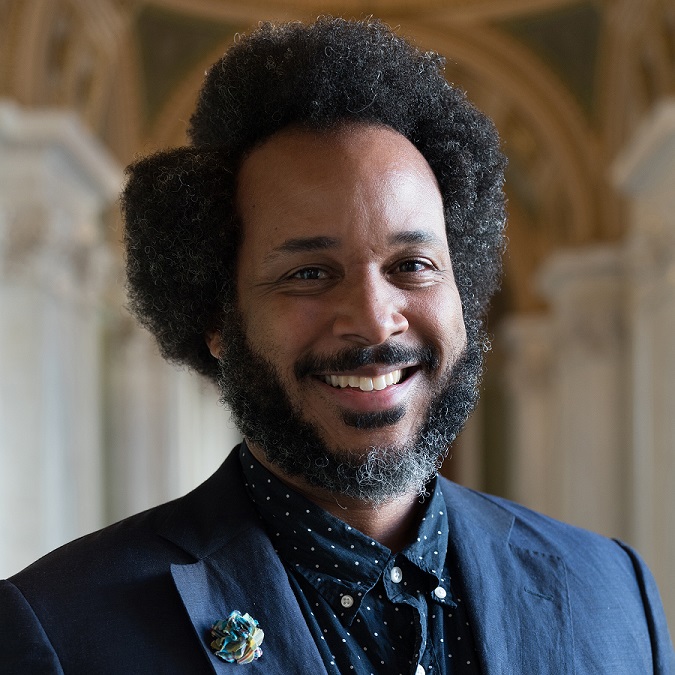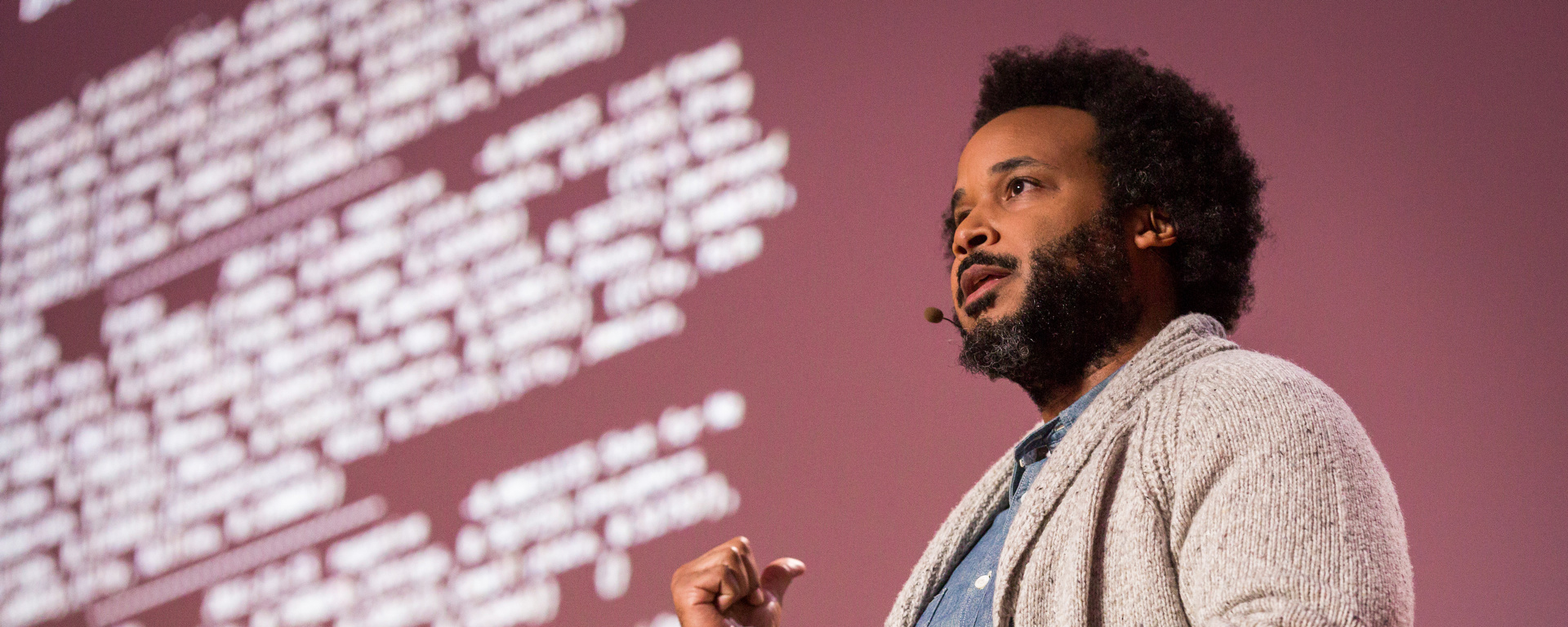UMBC’s Postdoctoral Fellowship for Faculty Diversity received over 500 applications this year, despite a pandemic that moved the entire process online for the first time. Emerging from that incredibly talented applicant pool was Tahir Hemphill, visual arts, who came to UMBC this fall as the inaugural Fellow for Faculty Diversity in the Visual Arts. This new track is specifically designed to support creative and artistic practitioners.
Hemphill is one of two Postdoctoral Fellows for Faculty Diversity to join UMBC’s College of Arts, Humanities, and Social Sciences this fall. He has developed a multifaceted practice as a creative technologist, multimedia artist, and design researcher. He uses his varied backgrounds in engineering and the arts to create graphic designs and projects that inform audiences about the world in which they live.

“I was groomed to be an electrical engineer,” Hemphill says. “So the physical sciences—chemistry, math, physics—play an important role in how I see, view, and understand the world.” Much of his current work utilizes computational analysis to explore what is usually unseeable in the semantic structures within large bodies of archival text, working especially within the world of hip-hop.
Developing his focus
Coming of age in the 1980s, Hemphill divided his time between practicing various elements of hip-hop culture and exploring cyberspace via a dial-up modem. A fundamental affinity between hip-hop culture and hacking would define the trajectory of his professional and creative life.
Starting in middle school, he accessed engineering-oriented opportunities to build and create, acquiring tech knowledge and skills. At the same time, hip-hop’s “golden era” informed his perspectives on popular culture and politics. He has synthesized the theoretical frameworks behind these two educational influences into his current creative endeavors.
Over the past 20 years, as an artist who works with technology, Hemphill has found inspiration in scientific work that pushes investigation to artistic limits and artistic work that pushes repetition towards scientific method. His reverence for the scientific method as well as his irreverent tinkering with it fuel this productive tension between art and technology.
A distinctive career path
Hemphill arrived at UMBC with broad experience in higher education, commercial design, and the non-profit sector. After earning a B.A. in Spanish language from Morehouse College, a strategic planning certificate from Miami Ad School, and a M.S. in communications design from the Pratt Institute, he went on to receive a Creative Research Fellowship at Carnegie Mellon University and a Hiphop Archive Fellowship at the W.E.B. Du Bois Institute for African and African American Research at Harvard University.
He has served as the Harissios Papamarkou Chair in Education at the John W. Kluge Center at the Library of Congress, and as Behavioral Science Resident at the Rockefeller Foundation Bellagio Center.
In the commercial sector, artist residencies at Spotify and Autodesk Pier 9 have recognized his creative work. He’s also received grants from the National Endowment for the Arts and the Saul Zaentz Innovation Fund. Additionally, the Talk to Me exhibition at the Museum of Modern Art in New York features his work.
Hip-hop as a lens on culture
In recent years, Hemphill’s work has concentrated on the intersection of hip-hop and data, manifested especially by the Rap Research Lab, a creative technology studio he founded to explore rap as a cultural indicator. The lab uses a hip-hop framework to develop new ways for people to engage with data and culture.
“Hip-hop is the most influential art form in the world today,” asserts Hemphill. “Whenever there’s an uprising in a country, there’s been a hip-hop song that goes along with it. People around the world tend to tap into the part that was for expressing opinions, revolution, going against the status quo.”
A Mapper’s Delight
In a recent presentation through UMBC’s Center for Innovation, Research, and Creativity in the Arts (CIRCA), Hemphill shared details on A Mapper’s Delight, an interactive virtual and augmented reality tool.
“It’s a sculptural data visualization,” Hemphill says, “and it’s built on a semantic relationship of hundreds of thousands of rap lyrics. It shows how…rappers cover the globe with their lyrics with references to cities, neighborhoods, regions.” He shares that “it looks at the geography of language and hip-hop, and creating language as political exercise.”
“All the projects, all the products that we build, sit on top of the rap almanac, and that’s a database of transcription and linguistic analysis—lyrics from about a million rap songs from 1979 to current day,” says Hemphill. A Mapper’s Delight analyzes those songs through algorithms. Once source material is in the database, “you can do a search for ‘power,’ and find every rapper that raps about power, where in the world they rap about power, when they rapped about power, the context,” he explains.
A Mapper’s Delight has added content in around 30 languages in the past year, says Hemphill, “so it’s truly a big data hip-hop cultural project.”
Mercedez Dunn, sociology, anthropology, and public health, is also a 2021-22 Postdoctoral Fellow for Faculty Diversity at UMBC. Learn about her work in this profile.
Header image: Tahir Hemphill speaks at TEDYouth in November 2014, Brooklyn Museum, Brooklyn, New York. Photo: Ryan Lash/TED. Attribution-NonCommercial 2.0 Generic license.
Tags: CAHSS, cahssresearch, Research, VisualArts




